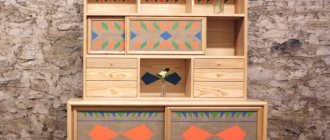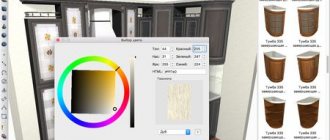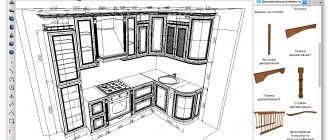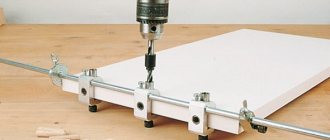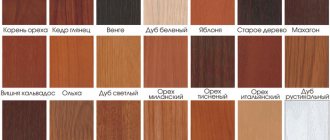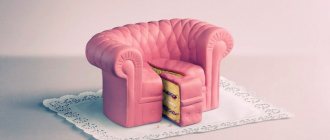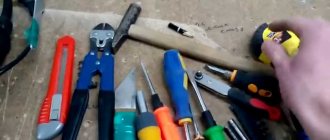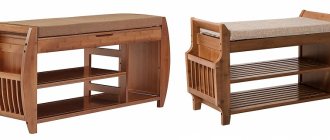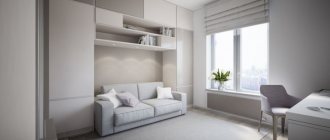Hello, dear reader! You wanted to make cabinet furniture with your own hands, but you stumbled on the first step. What if I tell you how, after reading this article, you can independently calculate the detailing of cabinet furniture?
Laminated chipboard is a popular material for furniture production in Russia. Knowing the thickness of the slab, the dimensions of the product and correctly drawing the assembly diagram. From which the position of the parts in the structure will be clear. You will be able to make calculations for cabinet furniture.
If it is difficult for you to draw a diagram, look at any bedside table for details. Try to understand what role each detail plays in the design. What problem does she solve with her presence? There are no unnecessary details in furniture.
DEPTH OF DESIGN
Anyone can become an on-site designer of kitchen and other cabinet furniture. This is possible due to the fact that each designer independently determines for himself the design depth to which he will dive. Including zero dive option. Let's take a step-by-step look at the main tasks that a field designer solves.
- 1.Search for a client
- 2. Sales meeting
- 3. Consulting
- 4. Measurement
- 5. Sketching
- 6. Design
- 7. Cost calculation
- 8. Preparation of documentation (payment for the order)
- 9. Order support in production
- 10. Delivery control
- 11. Installation control
- 12. Signing acceptance certificates
- 13. Order support during the warranty period
- 14. Post-warranty service
Some field designers make their own furniture and carry out the assembly and installation of furniture products. But these are rare exceptions. Moreover, it is recommended to concentrate on a minimum of tasks. This is the only way to increase your efficiency, and therefore productivity, which will ultimately affect your financial well-being. Trying to do all the work yourself will sooner or later affect your sales volume.
To increase sales, a successful field designer will sooner or later think about delegating the design task. That is why, as part of the project for training in planning custom-made kitchen furniture and creating any other cabinet furniture based on individual consumer projects, we offer this textbook for free - every successful designer is our potential partner. When the challenge of growth arises and the question arises of outsourcing the design stage, our partner’s candidacy will occupy an advantageous position. At this moment we can say that the depth of immersion in design becomes zero. Now the partners will be involved in the design.
A similar option may be chosen initially. Familiarity with the textbook materials allows you to understand the amount of work and level of responsibility that arises at the design stage. And not everyone has the desire to become a professional furniture designer.
Practical task
It is necessary to divide the above list of tasks of 14 points into two parts. In the first, you list the tasks that you would like to do on your own. The second contains tasks that you would like to delegate to your partners.
For each task from the second part, you need to find a business partner.
You can reach future partners through advertisements, information in the media, via the Internet, through business organizations and unions, through furniture showrooms
PRO100
PRO100 is a popular 3D modeling program that is distinguished by its simplicity and professional solutions. With its help, you can create high-quality projects and sketches in the shortest possible time. You can make changes directly in the presence of the customer, as it will take very little time.
Video tutorial on working in PRO100
PRO100 has a standard library with a large number of objects and materials, but in case that is not enough for you, you can create your own materials from a photograph or draw. You can create new furniture from existing elements or by downloading additional libraries from the Internet.
One of the features of this product is that it keeps track of the materials spent, so at the end of the project, you can generate a report that will indicate all the costs. Unfortunately, this is only available in the full paid version.
Also, here you will find many modes that will help you display your project in the most successful way. You can choose one of seven projections that will show the model from different sides and from different angles. And also select drawing mode, photorealism, shadows, transparency and others.
Using laminated chipboard in furniture making
reference Information
Chipboard - chipboard. It is a sheet material made by hot pressing wood particles mixed with a binder. Urea-formaldehyde, phenol-formaldehyde and other resins are used as binders. Chipboard is made from various shavings and other waste from sawmill, woodworking and plywood industries. The density of the chipboard board is in the range from 550 to 850 kg/m3.
The production of chipboards originated in the late 30s of the twentieth century in Germany and Switzerland. The reason for this progress is considered to be a sharp decrease in forest resources in Europe. Experts call two advantages of chipboard - ease of processing and cost-effectiveness.
Chipboards are classified in the following ways:
1st grade
There are slabs of 1st grade, 2nd grade, as well as non-grade slabs, which are usually used for construction purposes. For furniture, 1st grade chipboard is used. According to GOST 10632-89, such chipboard should not have depressions or protrusions, scratches, paraffin, dust or resin stains, chipped edges, chipped corners, under-polishing, or surface waviness. Plate thickness - 10-26 mm.
2. brand
Brands are characterized by physical and mechanical characteristics. The highest quality is the PA brand. It also has lower roughness, lower swelling percentage and higher flexural and tensile strength.
3. surface type
Firstly, they are divided according to the type of outer layer - large chips, a regular surface or a fine-textured surface. For example, chipboard with a fine-textured surface is considered to be of higher quality (at the end you can see how the inside of the chipboard is loose and compacts toward the surface).
Secondly, the slabs are divided according to the cladding. It may be completely absent (used for construction needs); there may be a decorative coating of films, veneer, laminate (laminated paper) and varnish.
The most popular is laminated chipboard. This is a chipboard lined with a film based on thermosetting polymers (paper-resin films).
Alternatives to lamination are lamination and veneering. Laminating is less reliable than lamination (the film often peels off), and veneering significantly increases the cost of chipboard.
4. Formaldehyde emission class
Chipboard is divided into classes E1 (up to 10 mg of formaldehyde per 100 g of dry board) and E2 (from 10 mg to 30 mg of formaldehyde per 100 g of dry board). E2 class chipboard is prohibited in the production of children's furniture. It is also prohibited to produce chipboards containing more than 30 mg of formaldehyde per 100 g of dry board.
5. degree of processing
If you don’t go into numbers, they are divided into sanded and unsanded chipboard.
6. water resistance
Chipboard is divided into regular and increased water resistance. The latter are marked with the letter “B”. The water resistance of laminated chipboard is given by a paraffin emulsion, which is introduced at the stage of pressing the board.
Water resistance is measured by swelling of the slab over 24 hours. For a regular P-A brand slab, the swelling is 22%. For a regular P-B brand slab it is 33%. For waterproof chipboard - up to 15%.
7. other
By adding various substances, new types of chipboards with the required properties are obtained. For example, fire resistant.
At the moment, in Belarus, Russia and Europe, chipboard is the main material used in the production of cabinet furniture. In its pure form, chipboard is practically not used, mainly laminated chipboard is used. At the same time, furniture makers use both the abbreviations “LDSP” and “LDStP”. Based on the fact that the buyer is still accustomed to the term chipboard, the on-site designer is forced to use this particular abbreviation.
Most often, designers and furniture makers in Minsk use 1st grade laminated chipboard of the P-A brand, class E1, with a laminated coating. Slabs with a thickness of 10mm, 16mm, 25mm are used.
Practical task
Receive chipboard samples from your manufacturing partner.
Development nuances
It is impossible to produce high-quality furniture without preliminary design work. To make an item yourself, you need to draw up a drawing. It is a graphic drawing of the product, made on a reduced scale and including the parameters necessary for its manufacture. Not only a design of the product is made, but also a drawing of the room where the furniture will be located.
Design is a rather complex process that requires special knowledge. Ideally, it is better to entrust this difficult job to a professional. If a person wants to start developing a drawing himself, he needs to adhere to the following algorithm of actions:
- decide on the type of future product;
- indicate its location;
- complete all measurements;
- select types of materials;
- start designing based on the results obtained;
- create a sketch;
- make adjustments if necessary;
- draw up a final technical design that allows you to assemble a high-quality product.
The project can be made based on a room with furniture that you like. For the convenience of drawing up documentation, it is recommended to use standard drawings and diagrams from manufacturers. They include:
- general form;
- list of accessories;
- assembly drawing;
- specifications;
- detailed drawings showing fastening locations, types of holes, edge locations.
You don't have to strictly follow this list. An individual manufacturer may change the contents of the list at his own discretion.
COMPLEX SHAPE PARTS
Parts made from chipboard are usually divided into parts of simple and complex shapes. There are a number of rules and restrictions that determine the possible appearance of parts with complex shapes. They are related to the production capabilities and performance characteristics of products and accessories.
Terms and Definitions
A part of complex shape is a part in which at least one of the angles is not equal to 90° and (or) one of the sides has a shape other than rectilinear.
Face - the largest surface of the slab.
Edge is the narrow side surface of a slab.
Edge covering is the process of covering the edge of a slab with edge material in order to improve the appearance, physical, mechanical and consumer properties.
Edge material is a strip or roll material intended for cladding the edges of slabs.
Dimension 1 is the distance measured in a direction parallel to the grain direction of the material.
Dimension 2 is the distance measured in the direction perpendicular to the grain direction of the material.
A workpiece is a rectangular fragment of a plate, into the contour of which the part must fit, taking into account the assigned technological allowances for processing.
An additive is a set of holes in furniture parts or the process of drilling these holes.
A groove is a recess, a recess in a part into which a protrusion of another part is inserted.
A fastening unit is a set of parts (accessories) that ensure the immobility of the connection of structures.
A sketch is a flat image of a part, made in accordance with the requirements of the rules for the design of sketches.
Finishing the edges of parts
The edges of the parts are lined with edging material (Fig. 1). In cabinet furniture, the most common edge material is 2 mm thick.
Finishing furniture edges
Fig.1. Finishing the edges of parts
Complex parts are processed with edge material after milling operations.
It is recommended not to apply an edge to the sides of the rectangular part that will be joined to the sides of other parts.
When facing with edging material 2 mm thick, a chamfer of 2x2 mm is formed at the joints of the edging materials. When using edges with a thickness of 0.4 and 1 mm, a chamfer is not formed.
Main technological limitations
Rectangular parts (Egger)
Maximum part size:
along the fibers. . . . . . . . . . 2770×1400 mm
across the grain. . . . . . . . . . 1400×2040 mm
Minimum part size. . . . . . . . . . . . . . 100x50 mm
The minimum size of the side intended for cladding with edge material is 100 mm.
Complex shaped parts (Egger)
Maximum workpiece dimensions:
along the fibers. . . . . . . . . . 2770×1200 mm
across the grain. . . . . . . . . . 1200×2040 mm
The permissible size of the narrowing of the part is 100 mm (Fig. 2).
Fig.2. Allowable narrowing
Internal corners are not allowed. An arc connection is required (Fig. 3).
Fig.3. Internal corner
Maximum radius of external and internal arc - 10000 mm
The minimum side size for cladding is 100 mm
Minimum radius of external arc - 50 mm
Minimum radius of the internal arc - 80 mm
Practical task
1) Obtain samples of edge material from the manufacturing partner.
2) Agree with production on the main technological limitations. Arrange as a table
Programs for 3D modeling
The need to visualize the working scene is mainly needed for the presentation of furniture and the development of catalogs. When designing furniture yourself, this fades into the background, although it can serve as a useful addition. The design process optimally takes place in programs like PRO100, KitchenDraw or WOODY - one of the few free, but somewhat outdated programs today. They have a function for quickly switching the displayed view, from a black and white sketch to a three-dimensional scene with its own light sources.
Three-dimensional model in WOODY 2.0
In the “BASIS” complex, for example, everything is not so rosy: the main work is carried out in the “Furniture Maker” module, and the construction of a visual concept, playing with colors, shadows and textures is moved to the “Salon” module, which is purchased separately. It cannot be argued that the possibility of visual assessment makes designing fun, but in professional activities it is rather a distraction.
"Basis-Salon"
Despite the availability of graphical tools, almost all work is carried out using parameterization methods. An object on the screen is just a display; it has a number of properties and features that are set manually through a parametric window. True, in a purely visual mode, you can quickly sort through the existing library of furniture, select the samples you like, quickly change the size and proportions (stretch, compress) of each individual product and make a global arrangement, and only then move on to working on the details.
INFLUENCE OF EDGE ON DIMENSIONS OF PART
For 16 mm laminated chipboards, edge material (hereinafter referred to as edge) with a thickness of 2 mm and a width of 19 mm is mainly used. When processing a part, excess edges are cut off and a chamfer is formed (Fig. 1). There are two important conclusions from this:
- — the edge reduces the size of the parts;
- — a chamfer on the edge of a part requires changing the dimensions of adjacent parts.
It is obvious that edge thickness reduces the size of the part. For example, if you need to make the side of a wardrobe with a depth of 600 mm, then such a part dimension can be obtained using an edge 2 mm thick only due to the fact that the depth of the part itself (saw size) will be equal to 598 mm. If such an edge is applied not only on the front, but also on the rear end of the part, then the size of the part will be 600-2-2 = 596 mm.
Using furniture design programs allows you to forget about these “little things” - the part is designed to be 600 mm in size, then an edge is applied to the specified ends and the program itself calculates the saw dimensions of the part.
The situation is a little more complicated with the influence of the edge on neighboring parts. Figure 4 shows an example when parts are placed without taking into account the thickness of the edge (for example, a side panel in a section on the right and a shelf on the left).
Fig.4. The appearance of a gap due to a chamfered edge
The resulting gap spoils the appearance of the product. Therefore, the part on the left is recessed by 2 mm (Fig. 5).
Fig.5. Correct placement of parts.
Considering that there can be a lot of parts and they can be located in relation to each other very differently, some care is required in determining the dimensions of the parts. Figure 6 shows an example of taking edge thickness into account.
Fig.6. No edge gap design
In Figure 6, parts 1 form the width and depth dimensions. Let us assume that the dimensions of parts 1 are as follows: width 600 mm, depth 300 mm. And let’s also assume that the 2 mm edge is applied only from the front part of the product. In this case, the depth of the sidewalls 2 will be 298 mm. Shelf 3 is recessed 2 mm narrower in relation to the sides 2. Therefore, the depth of part 3 will be 296 mm. Therefore, partition 4 will be designed with a depth of 294 mm, and shelf 5 - 292 mm. Thus, due to the thickness of the edge, the difference in depth between parts 1 and 5 was 8 mm!
It should be noted that such a principle cannot always be applied. There are exceptions when the designer is forced to make parts of the same depth and sacrifice aesthetics for functionality. Or, from an aesthetic point of view, you have to choose the lesser evil. Fortunately, the designer always has the opportunity to “play” with the details and change the design. Therefore, exceptions are very rare.
Similarly, a 1mm edge should be taken into account.
The 0.4 mm edge is usually neglected (especially in kitchen modules). However, it is recommended, with the exception of kitchen modules, to treat a 0.4 mm edge as a 1 mm edge. Those. recess adjacent parts 1 mm deep. This must be done for the reason that the error of sawing and additives in total is 0.5 ÷ 1 mm. Without recessing the parts, a situation is quite possible, for example, when the shelf appears to protrude in relation to the sides and the unlined ends become noticeable.
Practical task
Create several projects in the design program* with different combinations of partitions and shelves, taking into account an edge thickness of 2 mm.
Among furniture makers in Minsk, the design program “Basis - furniture maker” is most often used for design. In further lessons, any mention of software will mean “Basis” software products.
Required Tools
To achieve the best results, you will need patience and utmost attention. In this case, you cannot do without the right tools. To make cabinet furniture you will need:
- roulette;
- pencil;
- screwdriver;
- awl;
- drills for confirmations.
If you want to make furniture manufacturing your business and create a small production, then it is better to acquire:
- electric drill;
- jigsaw;
- milling cutter.
Since you will have to work mainly with wood, you will not need the most productive electric drill; a power of only 650 W is sufficient. With it you can quickly and effortlessly drill many straight holes in the parts of future furniture. A jigsaw will help you cut various materials, and to create even grooves or artistic carvings, use a router.
FASTENERS
For designing and assembling furniture according to individual projects, the following fasteners are used
- The corner is plastic. Used for fastening laminated chipboard parts at right angles in any plane - sidewalls, shelves, etc. Also used for attaching laminated chipboard parts to room walls. The corners are placed arbitrarily, based on the design features of the product. It is recommended to place the corners at a distance of at least 50 mm from the edge of the parts and in increments of approximately 500 mm.
- Confirmed screw . T-shaped fastening. L-shaped fastening. It is recommended to install two confirmatories at the junction of two parts. For example, when placing a shelf between the sidewalls, 4 confirmations will be required on the shelf (two for fastening with the left sidewall and two with the right sidewall). When connecting large-sized parts (for example, connecting the side of a cabinet and a console), the calculation of confirmations must be made based on the condition of placing confirmations with a pitch of 300-500 mm.
- Intersectional screed . Fixation of parts adjacent to the surface. 4 pieces are recommended. When connecting large parts (for example, two sides of sliding wardrobes), it is recommended to place ties every 1000 mm.
- Eccentric tie Rastex 15 Used for fastening parts made of laminated chipboard at right angles in any planes - sidewalls, shelves, rear walls, etc. It is attached similarly to the confirmat.
- Wooden dowel . The main use is in conjunction with Rastex when connecting parts, one of which lies in a vertical plane, and the other in a horizontal plane. Also used if products with invisible fasteners are needed (not recommended)
The use of eccentric ties Rastex and VB allows not only to improve the appearance of the product (most customers have a negative attitude towards visible corners), but also to solve the problem of repeated dismantling of the product. While the self-tapping screws will paint the chipboard each time, making the fastening less reliable, the eccentric screed completely retains its properties, since we exclude work with the slab from the dismantling process itself.
Among other things, we did not indicate the following fastening assortment: metal corners, self-tapping screws, dowels, plasterboard mounting, etc. It is believed that this fastener is required exclusively for installation, so it is not taken into account by the designer. Any installation team has a solid supply of such fasteners.
Mounting recommendations
The RASTEX eccentric coupler can be installed on shelves up to 900mm wide. Used for fastening any elements of the product. It is highly recommended to use in conjunction with a dowel.
The eccentric tie VB 35 is mainly used for fastening shelves to the sidewalls; it can be placed on shelves with a width of no more than 800 mm.
Confirmant is the most common mount. It is used either inside products or on front surfaces that are not visible after installation of the product.
The plastic corner is the most commonly used fastener. Has a morally outdated appearance. Using plastic corners, you can attach cabinet elements to each other, as well as attach the structure to the wall. Capable of withstanding fairly large loads on the shelf (1 corner can withstand up to 30 kg.) The width of the shelf when fastened with plastic corners should not exceed 900mm. In cabinet furniture, corners are common due to the irregular geometry of the premises and due to the need to fasten parts to the walls of the room.
Wooden dowels are mainly used for fastening structural elements with increased aesthetic requirements. This fastener cannot withstand heavy loads. Mainly used for fastening wooden boxes, for assembling kitchen boxes with front sides. In critical structures it must be used in conjunction with RASTEX.
Practical task
1) Obtain detailed information from the installation partner about the fasteners they use. Get advice and examples of using this or that type of fastener.
2) Coordinate with the manufacturing partner the fasteners used in the structures. The production must be equipped with equipment (additive machine), drills, cutters and other necessary tools.
Accessories
No furniture can do without high-quality and functional fittings - front and fasteners. The first type includes parts that serve only for decoration. This is an important part of the interior, which is always in sight. Facial accessories include:
- door handles;
- hooks for clothes;
- decorative locks and much more.
It is better to take products from Italian manufacturers - they are famous for their quality.
Depending on the design of the room, you can choose front fittings made of plastic, wood, metal or glass. There must be a special coating that reduces friction and protects against mechanical stress. Fittings of the second type perform the function of fasteners, connecting parts and increasing the reliability of furniture. It should be compact, durable and made of quality materials. This type includes:
- loops;
- shelf holders;
- bolts;
- mechanisms for drawing drawers;
- seals.
Furniture hinges are used to open door leaves, but with their help you can make a mechanism for transforming structures.
Door handles
Coat hooks
Locks
Loops
Shelf holders
Bolts
Drawer pull out mechanisms
Seals
FACADES AND CLEARANCES
Facades are divided into two groups - inset and overhead.
An overlay facade or an inset facade is determined relative to the part on which the hinges for the facade are installed. If the facade is superimposed on such a part, then it is called an inset and it requires overhead hinges. Figure 7 shows an inset façade, and Figure 8 shows an inlay. In both cases, the facade is hinged and the hinges are attached to the left side.
Fig.7. Inset facade
Fig.8. Overlay facade
As soon as we talk about facades, we immediately need to remember about gaps. The gap is the distance between the facade and surrounding parts. Figure 9 shows the gap between the inset facade and the sidewall, between the facade and the roof. As can be seen from the figure, the gap is 2 mm. This value is standard for most furniture makers and custom furniture designers.
Fig.9. Inset façade gaps
Fig. 10. Overlay façade gaps
Figure 10 shows the gaps of the overlay façade. With this option of two swing doors, the question arises of what gap to maintain between the facades. In the figure it is shown as 2 mm. In fact, the recommended gap between the facades is 4 mm.
Why? As you can see, if you place another product with hinged facades next to this structure, the gap between the outer facades of the modules will become 4 mm - for one it is 2 mm to the sidewall and for the second facade exactly the same. The gaps should be the same. Therefore, increasing the gap between the facades of one module will have a positive effect on the appearance of the structure as a whole.
Among other things, the increased gap of up to 4 mm does not limit the adjustment of the fronts and compensates for sawing and additive errors.
Practical task
Create several projects with different combinations of facades in the design program.
Cutting map
Furniture manufacturing begins with cutting out the main consumables. More often, cabinets, tables, and chests of drawers are made from chipboard or HDF. Let's say the sheet has standard dimensions 2750 x 1830 x 16 mm. To cut out the required parts, you need to draw up a cutting map. It provides schematic documentation indicating the elements that will be needed. Based on these drawings, the worker will cut out parts that correspond to the parameters of the future product. The remaining materials that need to be returned to the customer are also marked on the map.
The cutting map is a very important document and deserves a thorough study. The first sheet is called "Specification". Here is a list of elements. The product number is highlighted in a red circle at the very beginning of the table on the left. The word "Orientation" and three lines indicate the direction of the texture. On the cutting map it is predominantly horizontal. Four columns next to each other give an idea of integrity, size, quantity and material. On the right is information about the square footage and percentages of residues, parts, waste and cut length.
An important indicator is the cut; it directly affects the cost of cutting. The tariff is determined by footage. The cutting distance in mm must be divided by 1000. To find the total footage of all sheets, it is necessary to sum up the parameters.
Sheets of material are produced with errors, so they have to be sawed off at the edges. The offset is usually 5–15 mm. This work should not be counted in the cutting footage; the contractor should be warned about this in order to avoid unnecessary expenses. To learn to understand the meaning of the symbols on the map itself, it is worth studying a specific example.
| No. | Cipher | Name | Size | Quantity |
| 1 | 1–2 | Chipboard bulkhead | 2368 x 598 | 1 piece |
| 2 | 1–1 | Chipboard bulkhead | 2368 x 598 | 1 piece |
Stages of self-assembly of furniture, rules for decoding drawings
Dimensional data is plotted in the center of the line. The number in column 1 indicates the part number on the sheet. As for the code: the first digit here indicates the product number, the second - the part. This data and the name of the material on the map are recorded in the lower right corner. The designation of the remainder is given by the word of the same name.
Example of cutting map
Fiberboard and grooves
Fiberboard - wood fiber board. The production of fiberboard began quite a long time ago - in 1922, in the USA. Also, fiberboard is often called hardboard (organic stone). This is a sheet material made by hot pressing a mass of wood fibers laid in the form of a carpet. Fibers are individual tissue cells, their fragments or groups of wood cells obtained by steaming and grinding wood. That is why the reverse side of fiberboard resembles a “mesh”. By the way, due to this technology, fiberboard cannot be made in large thicknesses.
To improve the properties of fiberboard, synthetic resins are added to the sheets.
Fiberboard has its own narrow range of uses - the back walls of cabinet furniture, the bottom of drawers. Unlike plywood, which can also be used for these purposes, fiberboard is cheaper and more durable.
Considering that the main area of application for fiberboard is the back walls and bottoms of drawers, it is necessary to consider the issue of grooves.
A groove is a depression (cut) in any material.
For fiberboard, the groove is made 4 mm wide and 8-10 mm deep.
What is the connection between the fiberboard back wall and the groove? Yes, the fiberboard back wall can simply be nailed. Or you can make grooves in the sides and “hide” the back wall in the groove. This allows you to improve the appearance of the product - when viewing the structure from the side, the back wall will not be visible.
Thus, it makes sense to groove the sidewalls and other parts under the rear wall only when a side view of the structure is available. In other cases, a nailed back wall is a more economical and simpler option.
Fig. 11. Grooves in the sidewall and floor for the fiberboard back wall
Fig. 12. The back wall is made of fibreboard, installed in grooves. Front view.
In Figure 12 you can see that the rear wall is made slightly smaller than the depth of the groove. This makes it easier to install the back wall into the groove. The recommended gap is 1÷2 mm.
Installing the back wall into a groove is widely used in kitchen furniture, read the useful material from Kitchen.bel at the link.
Practical task
1) Create several projects with different grooves in the design program.
2) Create a project in the design program with the rear wall installed in the groove.
- home
- About the interior
- Custom-made furniture for comfort
- Basics of cabinet furniture design for beginners
→
→
→
Woodwork for Inventor
Shareware
Woodwork for Inventor is a professional program (more like a virtual carpentry studio) designed for use by equally professional carpenters.
Here are just some of the features and capabilities of Woodwork for Inventor:
- A variety of tools that allow you to create complex furniture designs from scratch. Users can work simultaneously with 2D sketches and 3D models, automatically creating bills of materials for their work projects.
- A wide selection of materials, decorations, fittings, surface textures, multilayer boards for creating composite parts. Here you can even choose the material with which the future sofa, armchair, or just sitting by the chair will be stuffed.
- Import of a binary file with a task for a CNC machine, which indicates the possibility of using the program in the work of furniture manufacturing companies. When creating a design, by the way, you can use a tool to automatically take into account the cutting, boring and turning attributes of the machine.
Woodwork for Inventor is available for free trial use for 45 days without functional limitations. After this time, some functions will no longer be available.
Advantages of hand-made furniture
Whether interior items are being made for the kitchen or another room, such designs have undoubted advantages :
- High quality - since you choose the material, accessories yourself, and control all stages of the creation process;
- Significant cost savings are the purchase of materials, that’s all the expenses;
- Creating a single interior ensemble - with hand-made furniture it is easier to make the interior harmonious;
- Gaining experience and moral satisfaction from the work done.
In addition, non-standard room sizes, corners and protrusions require appropriate furniture.
The main advantage of handmade furniture is its uniqueness.
You can create furniture that ideally matches the dimensions of the area allocated for it
KitchenDraw
“KitchenDraw” is recognized as one of the best professional programs for designing kitchens, the interface of which is designed specifically to simplify the work on creating kitchen furniture and interiors. Projects are created in the form of a flat drawing with the possibility of subsequent photographic volumetric visualization. The program has:
- extensive element catalogue;
- the ability to import catalogs of furniture manufacturers;
- the ability to create your own catalogs;
- the presence of an estimate calculation function;
- the ability to create a local network that unites several furniture sales points, with analytics functions and control over the operation of these points.
The program is aimed primarily at professionals who design and manufacture kitchens serially and on an individual basis. The use of the software is paid, and is billed hourly, but a free version with limited functionality is also available.
Online services
Bplanner
The Bplanner online application is often integrated into the websites of cabinet furniture stores. But you can also use it on the official website. There are software versions for creating cabinets and kitchens, and there is a VR version for viewing the interior in virtual reality.
The service is Russian-language and easy to understand. No special knowledge is needed - the user only enters the dimensions, moves the doors and shelves.
The application is free for the user, but for a site owner who wants to embed it, it will cost from 1,900 rubles per month.
Functions and capabilities:
- adjusting dimensions, materials, filling of cabinets, kitchen units;
- working with a project in 2D and 3D;
- mobile app;
- VR support;
- personal settings when installing on the site.
Pax3d
A non-standard service developed by IKEA. This is a full-fledged cabinet designer. The program only works with parts produced by the Swedish corporation.
The Pax3d application with a Russian interface is free, understandable even for those who do not understand furniture. The user simply drags ready-made elements into the three-dimensional interior of the room and arranges them together. You can then save or print the resulting cabinet.
Functions and capabilities:
- a rich library of structural elements from IKEA;
- interior customization;
- choice of material;
- built-in hints;
- saving a project using code on the site.
Prodboard
Prodboard is a simple designer of cabinets and kitchen sets. Not suitable for professionals, but will appeal to ordinary users who are choosing a cabinet and trying to understand how it will look in the interior. The settings are only basic; you cannot flexibly change the geometry of the cabinet furniture.
The application does not have a Russian interface, but is completely free.
Functions and capabilities:
- built-in library of standard structural elements;
- dimensions editor;
- interior customization;
- saving, printing the result.
Calculation of the wardrobe
This online service takes a different approach from all previous ones. There is no need to move or drag elements - just enter the numbers in the required fields. The program will draw a wardrobe and perform the required calculations.
The main task of the service is to calculate how much materials will be needed for the cabinet model of interest. This online tool does not work with other home furnishings.
Functions and capabilities:
- drawing up drawings;
- calculation of the required area of material;
- counting the number of holes for the drawing.
Many applications have been developed for designing furniture for any purpose and need. If you want to make a cabinet or table yourself, use one of the online resources. For use in an industrial enterprise, it is better to purchase a professional downloadable application.

